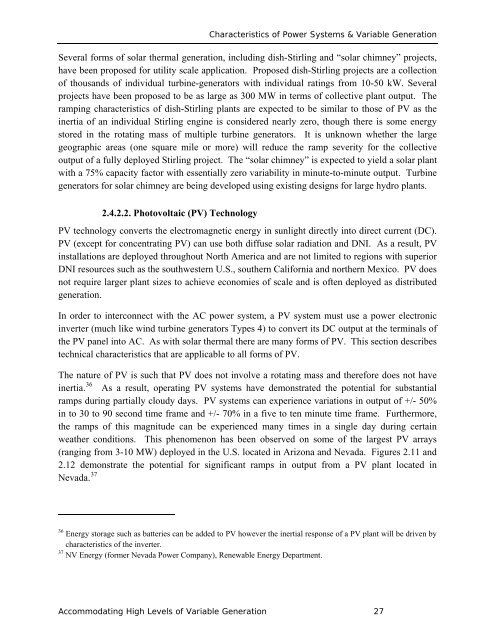Accommodating High Levels of Variable Generation - NERC
Accommodating High Levels of Variable Generation - NERC
Accommodating High Levels of Variable Generation - NERC
You also want an ePaper? Increase the reach of your titles
YUMPU automatically turns print PDFs into web optimized ePapers that Google loves.
Characteristics <strong>of</strong> Power Systems & <strong>Variable</strong> <strong>Generation</strong><br />
Several forms <strong>of</strong> solar thermal generation, including dish-Stirling and “solar chimney” projects,<br />
have been proposed for utility scale application. Proposed dish-Stirling projects are a collection<br />
<strong>of</strong> thousands <strong>of</strong> individual turbine-generators with individual ratings from 10-50 kW. Several<br />
projects have been proposed to be as large as 300 MW in terms <strong>of</strong> collective plant output. The<br />
ramping characteristics <strong>of</strong> dish-Stirling plants are expected to be similar to those <strong>of</strong> PV as the<br />
inertia <strong>of</strong> an individual Stirling engine is considered nearly zero, though there is some energy<br />
stored in the rotating mass <strong>of</strong> multiple turbine generators. It is unknown whether the large<br />
geographic areas (one square mile or more) will reduce the ramp severity for the collective<br />
output <strong>of</strong> a fully deployed Stirling project. The “solar chimney” is expected to yield a solar plant<br />
with a 75% capacity factor with essentially zero variability in minute-to-minute output. Turbine<br />
generators for solar chimney are being developed using existing designs for large hydro plants.<br />
2.4.2.2. Photovoltaic (PV) Technology<br />
PV technology converts the electromagnetic energy in sunlight directly into direct current (DC).<br />
PV (except for concentrating PV) can use both diffuse solar radiation and DNI. As a result, PV<br />
installations are deployed throughout North America and are not limited to regions with superior<br />
DNI resources such as the southwestern U.S., southern California and northern Mexico. PV does<br />
not require larger plant sizes to achieve economies <strong>of</strong> scale and is <strong>of</strong>ten deployed as distributed<br />
generation.<br />
In order to interconnect with the AC power system, a PV system must use a power electronic<br />
inverter (much like wind turbine generators Types 4) to convert its DC output at the terminals <strong>of</strong><br />
the PV panel into AC. As with solar thermal there are many forms <strong>of</strong> PV. This section describes<br />
technical characteristics that are applicable to all forms <strong>of</strong> PV.<br />
The nature <strong>of</strong> PV is such that PV does not involve a rotating mass and therefore does not have<br />
inertia. 36 As a result, operating PV systems have demonstrated the potential for substantial<br />
ramps during partially cloudy days. PV systems can experience variations in output <strong>of</strong> +/- 50%<br />
in to 30 to 90 second time frame and +/- 70% in a five to ten minute time frame. Furthermore,<br />
the ramps <strong>of</strong> this magnitude can be experienced many times in a single day during certain<br />
weather conditions. This phenomenon has been observed on some <strong>of</strong> the largest PV arrays<br />
(ranging from 3-10 MW) deployed in the U.S. located in Arizona and Nevada. Figures 2.11 and<br />
2.12 demonstrate the potential for significant ramps in output from a PV plant located in<br />
Nevada. 37<br />
36 Energy storage such as batteries can be added to PV however the inertial response <strong>of</strong> a PV plant will be driven by<br />
characteristics <strong>of</strong> the inverter.<br />
37 NV Energy (former Nevada Power Company), Renewable Energy Department.<br />
<strong>Accommodating</strong> <strong>High</strong> <strong>Levels</strong> <strong>of</strong> <strong>Variable</strong> <strong>Generation</strong> 27
















